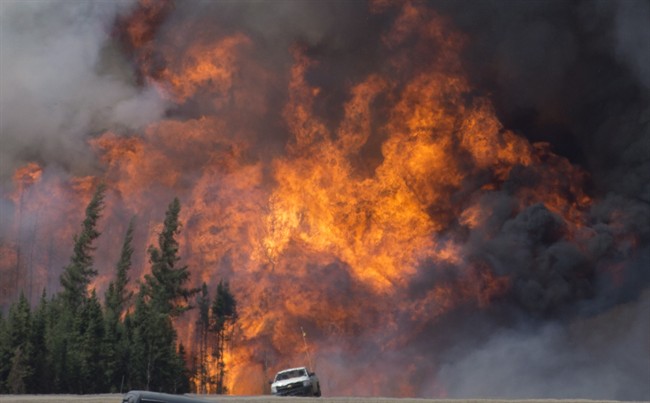Natural disasters from coast to coast triggered a staggering $4.9 billion in insurance claims in 2016, and we need to prepare for more wild weather, the Insurance Bureau of Canada (IBC) warned.

Last year’s numbers smashed the previous record of $3.2 billion in 2013.
The behemoth Fort McMurray wildfire easily claimed the title of biggest natural disaster of the year. The uncontrollable fire prompted the evacuation of roughly 100,000 people from their homes and caused widespread devastation. It resulted in approximately $3.7 billion in insurance claims, the most expensive disaster in Canadian history.
READ MORE: Climate change to double area burned by forest fires each year: Report
The community continues to rebuild.
Also of note: an ice storm in Ontario, hailstorms in the Prairies, and unrelenting rain that battered and flooded parts of the East Coast over the Thanksgiving weekend.
With the frequency and severity of such events on the rise, all levels of government need to not only ramp up natural disaster preparedness, but also work to combat climate change, the IBC urged.
“Severe weather due to climate change is already costing Canadians billions of dollars annually,” Don Forgeron, president and CEO of the Insurance Bureau of Canada, said in a release.
READ MORE: Earth on track to heat up to devastating levels by 2100, scientists say
“The record damage reported in 2016 is part of an upward trend that shows no signs of stopping. That is why Canada’s property and casualty insurance industry is calling on governments across the country to come together and implement expansive climate policies that will better prepare Canadians and their communities for when disasters strike.”
Globally, the annual economic cost of natural disasters has increased five-fold since the 1980s, according to IBC data.
READ MORE: Alberta holding 3-day emergency disaster exercise simulating ice storm
“This is one of the fallouts of a warmer world, and one that will be more troublesome than not, because of the fact that we’re not equipped to handle the heavier dose of rain,” Environment Canada’s senior climatologist David Phillips told Global News in December.
“It’s something we’ve known for centuries: Every time the world gets warmer, the atmosphere holds more moisture. A one-degree warming allows the atmosphere to hold, say, 12 per cent more precipitation — more rainfall or snow.”
Natural disasters are a huge financial and emotional burden. Experts agree preparing for a warmer world is imperative.
WATCH: Canadian researchers begin to study mental health impacts of Fort McMurray wildfire

“The reach of these storms and the effect they have on our communities is staggering,” Forgeron said.
“Canadians must be prepared both physically and economically for when these disasters inevitably strike. Addressing current gaps in public policy and consumer protection can only be possible if industry and government work together in the areas of mitigation, adaptation and emergency management – all of which form the basis of a comprehensive climate strategy.”
- 7 sent to hospital after carbon monoxide poisoning incident in northwest Calgary
- Calgary man accused of embezzling millions while working as financial adviser in Red Deer
- New Calgary puppet show encourages kids to find ‘magic moments’ in nature
- Speed a factor in serious-injury collision that sent motorcyclist to hospital: Calgary police












Comments